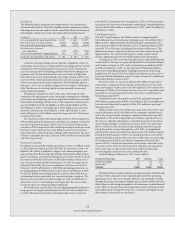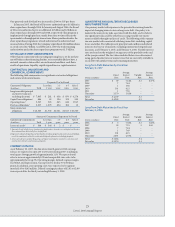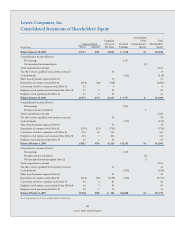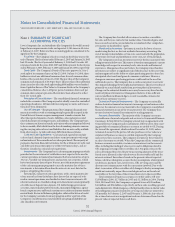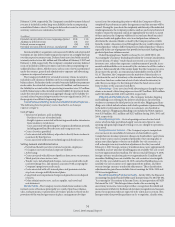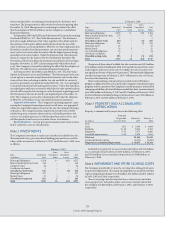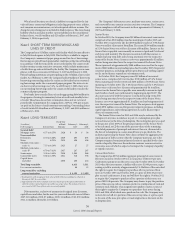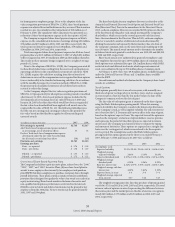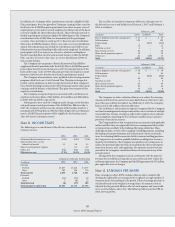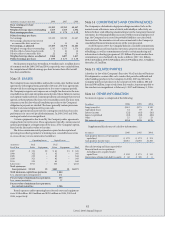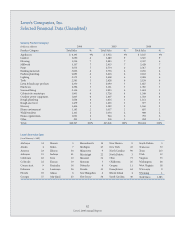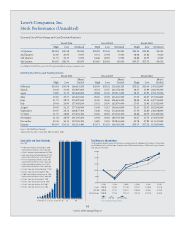Lowe's 2006 Annual Report Download - page 38
Download and view the complete annual report
Please find page 38 of the 2006 Lowe's annual report below. You can navigate through the pages in the report by either clicking on the pages listed below, or by using the keyword search tool below to find specific information within the annual report.
34
Lowe’s 2006 Annual Report
February 3, 2006, respectively. e Company’s extended warranty deferred
revenue is included in other long-term liabilities in the accompanying
consolidated balance sheets. Changes in deferred revenue for extended
warranty contracts are summarized as follows:
(In millions) 2006 2005
Extended warranty deferred revenue, beginning of period $206 $ 86
Additions to deferred revenue 148 130
Deferred revenue recognized (39) (10)
Extended warranty deferred revenue, end of period $315 $206
Incremental direct acquisition costs associated with the sale of extended
warranties are also deferred and recognized as expense on a straight-line basis
over the respective contract term. Deferred costs associated with extended
warranty contracts were $81 million and $54 million at February 2, 2007 and
February 3, 2006, respectively. e Company’s extended warranty deferred
costs are included in other assets (non-current) in the accompanying con-
solidated balance sheets. All other costs, such as costs of services performed
under the contract, general and administrative expenses and advertising
expenses are expensed as incurred.
e Company’s liability for extended warranty claims incurred is
included in self-insurance liabilities in the accompanying consolidated
balance sheets. Reductions in the extended warranty liability for payments
made under the extended warranties were $16 million, and increases in
the liability for accruals related to preexisting warranties were $17 million
in 2006. Reductions in the extended warranty liability for payments made
under the extended warranties and aggregate changes in the liability for
accruals related to preexisting warranties were not signicant in 2005, as
the program was still in its beginning stages.
Cost of Sales and Selling, General and Administrative Expenses –
The following lists the primary costs classified in each major
expense category:
Cost of Sales
• Total cost of products sold, including:
- Purchase costs, net of vendor funds;
- Freight expenses associated with moving merchandise inventories
from vendors to retail stores;
- Costs associated with operating the Company’s distribution network,
including payroll and benet costs and occupancy costs;
• Costs of services provided;
• Costs associated with delivery of products directly from vendors to
customers by third parties;
• Costs associated with inventory shrinkage and obsolescence.
Selling, General and Administrative
• Payroll and benet costs for retail and corporate employees;
• Occupancy costs of retail and corporate facilities;
• Advertising;
• Costs associated with delivery of products from stores to customers;
• ird-party in-store service costs;
• Tender costs, including bank charges, costs associated with credit
card interchange fees, and amounts associated with accepting the
Company’s proprietary credit cards;
• Costs associated with self-insured plans, and premium costs for
stop-loss coverage and fully insured plans;
• Long-lived asset impairment charges and gains/losses on disposal
of assets;
• Other administrative costs, such as supplies, and travel and
entertainment.
Vendor Funds – e Company receives funds from vendors in the
normal course of business principally as a result of purchase volumes,
sales, early payments, or promotions of vendors’ products. Based on the
provisions of the vendor agreements in place, management develops
accrual rates by estimating the point at which the Company will have
completed its performance under the agreement and the amount will be
earned. During the year, due to the complexity and diversity of the individual
vendor agreements, the Company performs analyses and reviews historical
trends to ensure the amounts earned are appropriately recorded. As a part
of these analyses, the Company validates its accrual rates based on actual
purchase trends and applies those rates to actual purchase volumes to
determine the amount of funds accrued by the Company and receivable
from the vendor. Amounts accrued throughout the year could be impacted
if actual purchase volumes dier from projected annual purchase volumes,
especially in the case of programs that provide for increased funding when
graduated purchase volumes are met.
Under Emerging Issues Task Force Issue No. 02-16 (EITF 02-16),
“Accounting by a Customer (Including a Reseller) for Certain Consideration
Received from a Vendor,” vendor funds are treated as a reduction of
inventory cost, unless they represent a reimbursement of specic, incre-
mental and identiable costs incurred by the customer to sell the vendor’s
product. Substantially all of the vendor funds that the Company receives
do not meet the specic, incremental and identiable criteria in EITF
02-16. erefore, the Company treats the majority of these funds as a
reduction in the cost of inventory as the amounts are earned and recog-
nizes these funds as a reduction of cost of sales when the inventory is
sold. ere is no impact to the timing of when the funds are received
from vendors or the associated cash ows.
Advertising – Costs associated with advertising are charged to oper-
ations as incurred. Advertising expenses were $873 million, $812 million
and $740 million in 2006, 2005 and 2004, respectively.
Shipping and Handling Costs – e Company includes shipping
and handling costs relating to the delivery of products directly from
vendors to customers by third parties in cost of sales. Shipping and han-
dling costs, which include salaries and vehicle operations expenses relating
to the delivery of products from stores to customers, are classied as
SG&A expenses. Shipping and handling costs included in SG&A expenses
were $310 million, $312 million and $255 million during 2006, 2005 and
2004, respectively.
Store Opening Costs – Costs of opening new or relocated retail
stores, which include payroll and supply costs incurred prior to store
opening and grand opening advertising costs, are charged to operations
as incurred.
Comprehensive Income – The Company reports comprehen-
sive income in its consolidated statements of shareholders’ equity.
Comprehensive income represents changes in shareholders’ equity from
non-owner sources and is comprised primarily of net earnings plus or
minus unrealized gains or losses on available-for-sale securities, as
well as foreign currency translation adjustments. For the year ended
February 2, 2007, foreign currency translation losses were approximately
$2 million, and net unrealized holding gains on available-for-sale securi-
ties were approximately $2 million. For the year ended February 3, 2006,
foreign currency translation gains were approximately $1 million and
unrealized holding losses on available-for-sale securities were insigni-
cant. For the year ended January 28, 2005, unrealized holding losses on
available-for-sale securities were approximately $1 million, and there
were no foreign currency translation adjustments. e reclassication
adjustments for gains/losses included in net earnings for 2006, 2005 and
2004 were insignicant.
Recent Accounting Pronouncements – In July 2006, the Financial
Accounting Standards Board (FASB) issued Interpretation No. 48 (FIN 48),
“Accounting for Uncertainty in Income Taxes, an interpretation of FASB
Statement No. 109.” is Interpretation claries the accounting for
uncertainty in income taxes and prescribes a recognition threshold and
measurement attribute for the nancial statement recognition and measure-
ment of a tax position taken or expected to be taken in a tax return. is
Interpretation also provides guidance on de-recognition, classication,


